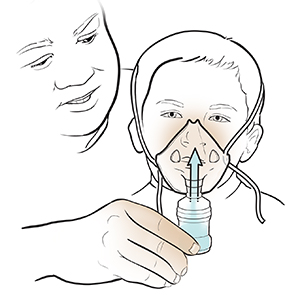A nebulizer is a device that delivers medicine directly to the lungs. It turns medicine into a fine mist. Your child breathes the mist in through a mask or a mouthpiece. To help your child use their nebulizer, follow the steps below.
With a mask
Tips for using a nebulizer with a mask include:
-
Wash your hands and make sure your child does, too.
-
Check the expiration date of the medicine. If the date is current, put the correct dose of medicine in the cup.
-
Attach the tubing from the air compressor or nebulizer to the medicine cup.
-
Next, attach the mask to the medicine cup.
-
Place the mask over your child's nose and mouth. Make sure it fits securely and comfortably.
-
Turn on the nebulizer.
-
Have your child take slow, deep breaths until all the medicine is gone. This takes
10 to 15 minutes. -
If your child takes inhaled steroids, make sure they wash their face afterward. The medicine can cause a rash.
With a mouthpiece
Tips for using a nebulizer with a mouthpiece include:
-
Wash your hands and make sure your child does, too.
-
Check the expiration date of the medicine. If the date is current, put the correct dose of medicine in the cup.
-
Attach the tubing from the air compressor or nebulizer to the medicine cup.
-
Next, attach the mouthpiece to the cup.
-
Have your child put the mouthpiece between their teeth and close their lips around it to create a tight seal. The tongue should be below the mouthpiece.
-
Turn on the nebulizer.
-
Have your child take slow, deep breaths through the mouthpiece until all the medicine is gone. This takes
10 to 15 minutes.
Important
Follow the manufacturer instructions for cleaning the air compressor or nebulizer and the mouthpiece. If you have any questions about using the nebulizer, ask your child's healthcare provider or nurse, your pharmacist, or someone from the manufacturer or local medical supply company.
Tips for using a nebulizer
Work with your child to make using a nebulizer as pleasant and as comfortable as possible. Here's what you can do, depending on your child's age:
-
For babies. Try to schedule treatments after meals, before naps, or at bedtime. If the noise bothers your baby, use longer tubing so the nebulizer is farther away. Or place the nebulizer on a towel or rug. Don't use the mask strap. Instead, hold the mask in place.
-
For toddlers. Tell your toddler it is about time for a treatment a few minutes before. Set up an area with special activities or toys that are just for nebulizer treatments. Let your child put a used mask on a favorite doll or stuffed animal. After the treatment, reward your child with your words or something they enjoy. Try to make the nebulizer treatment time as calm and unemotional as possible.
As your child gets a little older:
-
Explain the reasons for the treatments.
-
Try to let them be more independent.
-
Talk with their healthcare provider about using an inhaler with a spacer instead of a nebulizer.
Featured in


